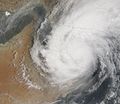File:Gonu 06 jun 2007 0715Z.jpg

Size of this preview: 692 × 600 pixels. Other resolutions: 277 × 240 pixels | 554 × 480 pixels | 886 × 768 pixels | 1,182 × 1,024 pixels | 2,363 × 2,048 pixels | 3,900 × 3,380 pixels.
Original file (3,900 × 3,380 pixels, file size: 1.15 MB, MIME type: image/jpeg)
File history
Click on a date/time to view the file as it appeared at that time.
| Date/Time | Thumbnail | Dimensions | User | Comment | |
|---|---|---|---|---|---|
| current | 15:18, 9 June 2007 |  | 3,900 × 3,380 (1.15 MB) | Good kitty | == Summary == {{Information |Description=A cyclonic storm like Tropical Cyclone Gonu might not seem an odd sight until you consider that Gonu is heading northwest into the Gulf of Oman. The most recent storm of this magnitude to hit the Sultanate of Oman |
File usage
The following pages on the English Wikipedia use this file (pages on other projects are not listed):


